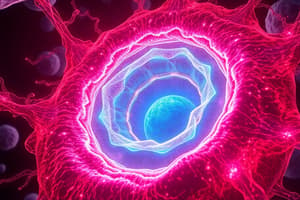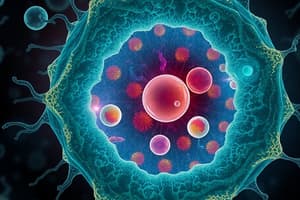Podcast
Questions and Answers
What is the primary function of the nuclear envelope?
What is the primary function of the nuclear envelope?
- Regulating the movement of molecules between the nucleus and the cytoplasm (correct)
- Transporting all molecules directly into the nucleus
- Synthesizing ribosomal RNA
- Storing proteins for cellular metabolism
Which component of the chromatin is critical for organizing and condensing DNA?
Which component of the chromatin is critical for organizing and condensing DNA?
- Nuclear pores
- Lamina proteins
- Histone proteins (correct)
- Nucleotides
How does the outer membrane of the nuclear envelope facilitate cellular function?
How does the outer membrane of the nuclear envelope facilitate cellular function?
- By aiding in DNA replication
- By synthesizing ribosomes
- By being continuous with the rough endoplasmic reticulum (correct)
- By organizing chromatin structures
Which process is directly facilitated by nuclear pores?
Which process is directly facilitated by nuclear pores?
What role do lamin proteins play in the nucleus?
What role do lamin proteins play in the nucleus?
What is chromatin mainly composed of?
What is chromatin mainly composed of?
Which statement correctly describes the function of nuclear pores?
Which statement correctly describes the function of nuclear pores?
What type of genetic material is primarily contained in the nucleus?
What type of genetic material is primarily contained in the nucleus?
What role do histone proteins play in the organization of DNA?
What role do histone proteins play in the organization of DNA?
What is the primary function of the nucleolus?
What is the primary function of the nucleolus?
How do methylation and acetylation of histone proteins affect gene expression?
How do methylation and acetylation of histone proteins affect gene expression?
What is the relationship between ribosomes and the nucleolus?
What is the relationship between ribosomes and the nucleolus?
What form of DNA is associated with inactive genes?
What form of DNA is associated with inactive genes?
What is the effect of histone acetylation on DNA structure?
What is the effect of histone acetylation on DNA structure?
Why is DNA condensation important during mitosis?
Why is DNA condensation important during mitosis?
What results from the methylation of histone proteins?
What results from the methylation of histone proteins?
What role do ribosomes play in the cell?
What role do ribosomes play in the cell?
Where are ribosomal subunits assembled?
Where are ribosomal subunits assembled?
What is the function of the nucleolus within the nucleus?
What is the function of the nucleolus within the nucleus?
How do nuclear pores function in the transport of molecules?
How do nuclear pores function in the transport of molecules?
Which statement best describes chromatin's role in the nucleus?
Which statement best describes chromatin's role in the nucleus?
What is the primary function of the outer membrane of the nuclear envelope?
What is the primary function of the outer membrane of the nuclear envelope?
Which of the following is NOT a characteristic feature of eukaryotic cells?
Which of the following is NOT a characteristic feature of eukaryotic cells?
In eukaryotic cells, what is the primary role of lamins found in the inner membrane of the nuclear envelope?
In eukaryotic cells, what is the primary role of lamins found in the inner membrane of the nuclear envelope?
What is the result of DNA replication that occurs in chromatin?
What is the result of DNA replication that occurs in chromatin?
What are nucleosomes primarily composed of?
What are nucleosomes primarily composed of?
What is the immediate effect of adding a methyl group to histone proteins?
What is the immediate effect of adding a methyl group to histone proteins?
Which describes the role of ribosomal proteins in the nucleolus?
Which describes the role of ribosomal proteins in the nucleolus?
Which statement accurately describes euchromatin?
Which statement accurately describes euchromatin?
What is the primary role of rRNA in the nucleolus?
What is the primary role of rRNA in the nucleolus?
How are ribosomes involved in protein synthesis?
How are ribosomes involved in protein synthesis?
What structure within the nucleus is primarily responsible for synthesizing ribosomal RNA?
What structure within the nucleus is primarily responsible for synthesizing ribosomal RNA?
What type of chromatin is associated with active gene transcription?
What type of chromatin is associated with active gene transcription?
What is the primary purpose of the nuclear envelope?
What is the primary purpose of the nuclear envelope?
Which of the following molecules can passively diffuse through nuclear pores?
Which of the following molecules can passively diffuse through nuclear pores?
What are lamins primarily associated with in the nucleus?
What are lamins primarily associated with in the nucleus?
What is the main function of histone proteins in relation to DNA?
What is the main function of histone proteins in relation to DNA?
What is a primary characteristic of prokaryotic cells compared to eukaryotic cells?
What is a primary characteristic of prokaryotic cells compared to eukaryotic cells?
Which process allows for the copying of DNA in preparation for cell division?
Which process allows for the copying of DNA in preparation for cell division?
Flashcards are hidden until you start studying
Study Notes
The Nucleus: Structure and Function
- The nucleus is a membrane-bound organelle found in eukaryotic cells.
- It contains the cell's genetic material, DNA, in the form of chromatin.
- The nucleus is essential for the cell's survival, regulating cellular activity, and ensuring proper cell replication.
The Nuclear Envelope
- The nuclear envelope is a double membrane structure that surrounds the nucleus.
- It consists of two phospholipid bilayers: an outer membrane and an inner membrane.
- The outer membrane is contiguous with the endoplasmic reticulum (ER), specifically the rough ER.
- The inner membrane contains a protein layer called the lamina, composed of lamin proteins.
- Embedded within the nuclear envelope are nuclear pores, which act as channels for the transport of molecules between the nucleus and the cytoplasm.
Functions of the Nuclear Envelope
- Outer Membrane: Continuous with the rough ER, facilitating the movement of mRNA from the nucleus to ribosomes on the rough ER for protein synthesis.
- Inner Membrane: Contains lamin proteins, involved in:
- DNA replication: The process of copying DNA for cell division.
- DNA transcription: The process of converting DNA into RNA.
- Organization and condensation of DNA within the nucleus.
- Nuclear Pores: Act as channels for the transport of molecules between the nucleus and the cytoplasm:
- Import: Allowing for the passive transport of small molecules (e.g., ions, nucleotides) into the nucleus.
- Export: Allow for the active transport of large molecules (e.g., mRNA, proteins) out of the nucleus, requiring ATP.
Nuclear Content
- The nuclear content comprises two main components: chromatin and the nucleolus.
Chromatin
- Chromatin is a complex of DNA and proteins found within the nucleus.
- It consists mainly of:
- Histone proteins: Positively charged proteins that bind to DNA, which is negatively charged.
- DNA: The cell's genetic material, containing the instructions for cellular function.
- The interaction between histone proteins and DNA results in the formation of nucleosomes, which help condense and organize DNA.
Functions of Chromatin
- DNA Replication: Chromatin allows for the duplication of DNA during cell division (mitosis).
- DNA Transcription: Chromatin allows for the process of transcribing DNA into RNA, which is essential for protein synthesis.
- Organization and Condensation of DNA: Histone proteins help package and compress DNA into a more compact form, making it more manageable within the nucleus.
The Nucleolus
- The nucleolus is a prominent structure within the nucleus, responsible for the synthesis of ribosomes.
- Ribosomes are essential for protein synthesis, as they act as the site of protein translation.
- The nucleolus contains rRNA (ribosomal RNA) and ribosomal subunits, which combine to form functional ribosomes.
- After assembly, ribosomes are exported from the nucleus into the cytoplasm, where they participate in protein production.
Histone Proteins
- Histone proteins condense DNA, allowing it to fit inside the nucleus.
- DNA condensation is crucial for mitosis as it prevents breakage and damage to the DNA.
- Condensed DNA forms chromosomes.
- Histone proteins regulate gene expression by tightening or loosening DNA.
- Methylation of histone proteins causes DNA condensation, inhibiting transcription.
- This condensed DNA is called heterochromatin and is associated with inactive genes.
- Acetylation of histone proteins loosens DNA, allowing for transcription.
- This loosened DNA is called euchromatin and is associated with active genes.
Nucleolus
- The nucleolus is the site of rRNA and ribosomal synthesis
- The nucleolus produces rRNA from DNA.
- The nucleolus also produces ribosomal subunits from proteins.
- Ribosomal subunits combine with rRNA in the nucleolus to form ribosomes.
- Ribosomes are exported from the nucleus through nuclear pores.
- Ribosomes are essential for protein synthesis.
The Nucleus
- The nucleus is a membrane-bound organelle, found in eukaryotic cells.
- Contains the cell's genetic material (DNA) in the form of chromatin
- Essential for cell function. Regulates cellular activity and ensures proper cell replication.
The Nuclear Envelope
- A double-membrane structure surrounding the nucleus.
- Consists of an outer and inner membrane.
- Outer membrane is contiguous with the rough endoplasmic reticulum (ER).
- Inner membrane has a protein layer, called the lamina, composed of lamin proteins.
- Nuclear pores embedded within the envelope act as channels for molecular transport between the nucleus and cytoplasm.
Functions of the Nuclear Envelope
- Outer Membrane: Continuous with the rough ER, allowing for the movement of mRNA from the nucleus to ribosomes on the rough ER for protein synthesis.
- Inner Membrane: Contains lamin proteins, involved in DNA replication, transcription, and organization and condensation of DNA within the nucleus.
- Nuclear Pores: Channels for transport between the nucleus and cytoplasm.
- Import: Passive transport of small molecules (e.g., ions, nucleotides) into the nucleus.
- Export: Active transport of large molecules (e.g., mRNA, proteins) out of the nucleus, requiring ATP.
Nuclear Content
- Comprises chromatin and the nucleolus.
Chromatin
- A complex of DNA and proteins found within the nucleus.
- Consists of histone proteins and DNA
- Histone proteins bind to DNA, resulting in the formation of nucleosomes, which condense and organize DNA.
Functions of Chromatin
- DNA Replication: Allows for DNA duplication during cell division.
- DNA Transcription: Allows for the transcription of DNA into RNA, essential for protein synthesis.
- Organization and Condensation of DNA: Histone proteins compress DNA into a more manageable form within the nucleus.
The Nucleolus
- A prominent structure within the nucleus, responsible for the synthesis of ribosomes.
- Contains rRNA (ribosomal RNA) and ribosomal subunits, which combine to form functional ribosomes.
- Ribosomes are exported from the nucleus into the cytoplasm for protein production.
Histone Proteins
- Condense DNA, enabling it to fit inside the nucleus.
- DNA condensation is crucial for preventing breakage and damage during mitosis.
- Condensed DNA forms chromosomes.
- Regulate gene expression by tightening or loosening DNA.
- Methylation of histone proteins causes DNA condensation, inhibiting transcription. (Heterochromatin, inactive genes)
- Acetylation of histone proteins loosens DNA, allowing for transcription. (Euchromatin, active genes)
Nucleolus
- The site of rRNA and ribosomal synthesis.
- Produces rRNA from DNA.
- Produces ribosomal subunits from proteins.
- Ribosomal subunits and rRNA combine to form ribosomes.
- Ribosomes are exported from the nucleus through nuclear pores, essential for protein synthesis.
Cell Nucleus: The Control Center
- The nucleus is the cell's control center, containing the genetic material (DNA) and directing cellular activities.
- It's surrounded by the nuclear envelope, a double membrane structure.
Nuclear Envelope: A Protective Barrier
- The outer membrane is continuous with the endoplasmic reticulum (ER), allowing for easy passage of molecules.
- The inner membrane contains lamins, proteins essential for DNA replication, transcription, and structural support.
- The nuclear pores are passageways between the inner and outer membranes, allowing for controlled movement of molecules in and out of the nucleus.
- The nuclear pores are crucial for the cell's communication with the outside world.
Inside the Nucleus:
- The nucleolus is a dense region within the nucleus responsible for the synthesis of ribosomal RNA (rRNA) and ribosomal subunits.
- Chromatin is the complex of DNA and proteins (histones) that makes up the genetic material.
- Histones are positively charged proteins that bind to negatively charged DNA, compacting the DNA and helping it fit inside the nucleus.
Functions of the Nuclear Envelope and Content
- The outer membrane facilitates the movement of mRNA (messenger RNA) from the nucleus to ribosomes in the cytoplasm for protein synthesis.
- The inner membrane lamins play a critical role in DNA replication, transcription, and maintaining the shape of the nucleus.
- Nuclear pores allow for the import (bringing molecules into the nucleus) and export (sending molecules out of the nucleus) of molecules.
- Import of small molecules is often passive, while the import/export of larger molecules usually requires energy (ATP) and active transport.
- Chromatin is involved in DNA replication, creating copies of DNA for cell division (mitosis), and DNA transcription, creating RNA molecules from DNA.
- DNA's organization within the nucleus is facilitated by the nucleosomes, formed when DNA wraps around histone proteins.
- The nucleolus is responsible for producing rRNA and ribosomal subunits, which are necessary for protein synthesis.
Eukaryotic vs. Prokaryotic Cells
- Eukaryotic cells, like animal and plant cells, possess a true nucleus and other membrane-bound organelles.
- Prokaryotic cells, like bacteria, lack a defined nucleus and membrane-bound organelles; they have genetic material concentrated in a region called the nucleoid.
DNA Condensation and Histones
- Histone proteins compact DNA, allowing the two meters of DNA present in a human cell to fit inside the nucleus.
- This DNA condensation is essential for mitosis, preventing DNA damage during the process.
- Chromosomes are highly condensed and organized structures of DNA wrapped around histones.
Histone Modifications and Gene Expression
- Methylation of histones leads to DNA condensation, inhibiting transcription and forming heterochromatin, which is inactive DNA.
- Acetylation of histones loosens DNA, promoting transcription and forming euchromatin, which is active and expressed DNA.
Nucleolus: rRNA and Ribosomal Synthesis
- The nucleolus is responsible for synthesizing ribosomal RNA (rRNA) and ribosomal subunits.
- DNA produces mRNA, rRNA, and tRNA (transfer RNA), all involved in protein synthesis.
- Ribosomes are found free in the cytoplasm or bound to the rough endoplasmic reticulum (RER).
- mRNA binds to ribosomes, and ** tRNA** carries specific amino acids to synthesize proteins during translation.
Ribosome Assembly and Export
- The ribosomal subunits produced in the nucleolus combine with rRNA to form functional ribosomes.
- These ribosomes will be exported from the nucleus through the nuclear pores.
- Ribosomes play a crucial role in protein synthesis by translating mRNA into proteins.
Nucleus
- The nucleus is the control center of eukaryotic cells, containing the cell's genetic material (DNA).
- The nuclear envelope encloses the nucleus, separating it from the cytoplasm.
- The nuclear envelope is composed of two membranes: an outer membrane continuous with the rough endoplasmic reticulum (RER) and an inner membrane containing a lamina layer made of lamins (proteins).
- Nuclear pores are channels through the nuclear envelope, allowing for the transport of molecules in and out of the nucleus.
- Nuclear content includes the nucleolus and chromatin.
- Chromatin is a complex of DNA and histones, responsible for packaging and organizing DNA.
- Histones are positively charged proteins that bind to and condense negatively charged DNA.
- DNA replication is the process of copying DNA, enabling cell division (mitosis).
- DNA can be transcribed into RNA, forming different types of RNA, including mRNA, tRNA, and rRNA.
- mRNA is translated into proteins by ribosomes.
- Ribosomes are composed of rRNA and ribosomal proteins.
- The nucleolus is responsible for ribosome synthesis, where rRNA is synthesized and assembled with ribosomal proteins.
- Small molecules and ions can passively diffuse through nuclear pores, while larger molecules, like RNA and proteins, require active transport (using ATP).
- Lamin proteins play a key role in DNA replication, DNA transcription, and organizing DNA within the nucleus.
- Chromatin exists in two forms: euchromatin (loosely packed DNA, actively transcribed) and heterochromatin (tightly packed DNA, inactive).
Histone Proteins
- Histone proteins are essential for DNA condensation, efficiently packing DNA into the nucleus, preventing damage, and facilitating mitosis.
- Chromosomes are formed during mitosis as DNA tightly condenses around histone proteins.
- Gene regulation is influenced by histone modifications:
- Methylation of histone proteins can induce DNA condensation, inhibiting transcription and creating heterochromatin.
- Acetylation of histone proteins can loosen DNA, stimulating transcription and creating euchromatin.
Nucleolus
- The nucleolus is a specialized region within the nucleus responsible for the synthesis of rRNA and ribosomal subunits.
- rRNA Synthesis: DNA transcribes rRNA, which is transported to the nucleolus.
- Ribosomal Subunit Synthesis: Ribosomal proteins, synthesized through a prior ribosome, are transported to the nucleolus.
- Ribosome Assembly: Ribosomal subunits combine with rRNA in the nucleolus to form ribosomes.
- Ribosome Export: Ribosomes are exported from the nucleus through nuclear pores.
- Protein Synthesis: Ribosomes play a crucial role in protein synthesis, either as free ribosomes in the cytosol or bound to the rough endoplasmic reticulum.
Studying That Suits You
Use AI to generate personalized quizzes and flashcards to suit your learning preferences.



